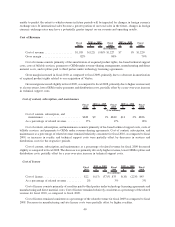Symantec 2010 Annual Report Download - page 126
Download and view the complete annual report
Please find page 126 of the 2010 Symantec annual report below. You can navigate through the pages in the report by either clicking on the pages listed below, or by using the keyword search tool below to find specific information within the annual report.accounting in a multiple element arrangement and requires the allocation of arrangement consideration to each
deliverable to be based on the relative selling price. The new standard establishes a selling price hierarchy that
allows for the use of an estimated selling price to determine the allocation of arrangement consideration to a
deliverable in a multiple element arrangement where neither VSOE nor TPE is available for that deliverable.
Concurrently to issuing the new standard, the FASB also issued new authoritative guidance that excludes tangible
products that contain software and non-software elements that function together to provide the tangible products’
essential functionality from the scope of software revenue guidance. We have elected to adopt the new accounting
standards as of the beginning of fiscal 2010 for applicable transactions originating from or materially modified after
April 2, 2009. Our adoption did not have a material impact on our financial statements. Our joint venture also
adopted the accounting standards during its period ended December 31, 2009, which was applied to the beginning
of its fiscal year. As a result of the joint venture’s adoption of the accounting standards, our Loss from joint venture
decreased by $12 million during our fiscal 2010. See Note 6 for further details regarding the impact of this guidance
on our joint venture.
Recently Issued Authoritative Guidance
In June 2009, the FASB issued revised guidance which changes the model for determining whether an entity
should consolidate a variable interest entity (“VIE”). The standard replaces the quantitative-based risks and rewards
calculation for determining which enterprise has a controlling financial interest in a VIE with an approach focused
on identifying which enterprise has the power to direct the activities of a VIE and the obligation to absorb losses of
the entity or the right to receive the entity’s residual returns. The statement is effective as of the first quarter of our
fiscal 2011, and early adoption is prohibited. We do not expect the adoption of this new authoritative guidance to
have a material impact on our consolidated financial statements.
Item 7A. Quantitative and Qualitative Disclosures about Market Risk
We are exposed to various market risks related to fluctuations in interest rates, foreign currency exchange rates,
and equity prices. We may use derivative financial instruments to mitigate certain risks in accordance with our
investment and foreign exchange policies. We do not use derivatives or other financial instruments for trading or
speculative purposes.
Interest Rate Risk
Our exposure to interest rate risk relates primarily to our short-term investment portfolio and the potential
losses arising from changes in interest rates. Our investment objective is to achieve the maximum return compatible
with capital preservation and our liquidity requirements. Our strategy is to invest our cash in a manner that preserves
capital, maintains sufficient liquidity to meet our cash requirements, maximizes yields consistent with approved
credit risk, and limits inappropriate concentrations of investment by sector, credit, or issuer. We classify our cash
equivalents and short-term investments in accordance with the authoritative guidance on investments. We consider
investments in instruments purchased with an original maturity of 90 days or less to be cash equivalents. We classify
our short-term investments as available-for-sale. Short-term investments consist of marketable debt or equity
securities with original maturities in excess of 90 days. Our cash equivalents and short-term investment portfolios
consist primarily of money market funds, commercial paper, corporate debt securities, and U.S. government and
government-sponsored debt securities. Our short-term investments do not include equity investments in privately
held companies. Our short-term investments are reported at fair value with unrealized gains and losses, net of tax,
included in Accumulated other comprehensive income within Stockholders’ equity in the Consolidated Balance
Sheets. The amortization of premiums and discounts on the investments, realized gains and losses, and declines in
value judged to be other-than-temporary on available-for-sale securities are included in Other income, net in the
Consolidated Statements of Operations. We use the specific identification method to determine cost in calculating
realized gains and losses upon sale of short-term investments.
50
























